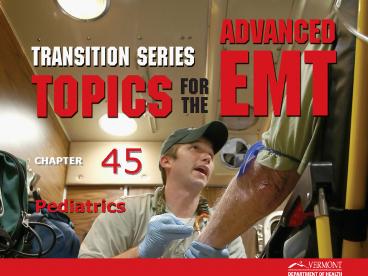Pediatrics - PowerPoint PPT Presentation
1 / 24
Title:
Pediatrics
Description:
Review the Pediatric Assessment Triangle and how to implement it with pediatrics. Discuss common pediatric pathologies and their corresponding management. – PowerPoint PPT presentation
Number of Views:688
Avg rating:3.0/5.0
Title: Pediatrics
1
45
Pediatrics
2
Objectives
- Discuss how to approach the pediatric patient.
- Review the Pediatric Assessment Triangle and how
to implement it with pediatrics. - Discuss common pediatric pathologies and their
corresponding management.
3
Introduction
- Managing pediatrics requires
- Personal preparation
- EMS system preparation
- Hospital network system preparation
4
Approach First Impression
- First impressions matter more to children.
- They don't have the experiences to make correct
judgments. - Get down to their level with the caregiver
present. - Assessment starts as soon as you arrive.
5
Approach a young child on the childs level, with
the caregiver present.
6
Parents and Caretakers
- Parents and caretakers know you are there to
help. - It doesn't mean they trust you.
- Gaining parent's trust will help in gaining the
child's trust.
7
Assessment
- Assessment of the pediatric patient differs from
that of the adult patient. - Rapid changes in anatomy, physiology, and
cognitive ability. - Vitals change during development.
8
Assessment (contd)
- Pediatric Assessment Triangle
- Modifies traditional ABCs of airway-breathing-circ
ulation to appearance-breathing-circulation. - Outside APGAR, PAT allows for objective and
reproducible evaluation of sick pediatrics.
9
The Pediatric Assessment Triangle (PAT). (Used
with permission of the American Academy of
Pediatrics.) Source General Approach to
Pediatric Assessment
10
Assessment (contd)
- Appearance
- Often the first clues to a problem are found in
the appearance. - TICLS mnemonic can help.
- Tone
- Interactiveness
- Consolability
- Look/Gaze
- Speech/Cry
11
Assessment (contd)
- Breathing
- Ventilation needed for respiration.
- Respiration needed for energy and cellular
activity. - Pediatric respiratory system is ill-equipped to
handle significant disturbances.
12
Assessment (contd)
- Circulation
- Relationship of pump, pipes, and fluid.
- When one fails, the other two have to cover.
- Causes
- Volume loss
- Pump failure
- Low vascular tone
- IV versus IO access.
13
Case Study
- You are called to the home of a 5-year-old child
who reportedly fell off a climbing gym in his
back yard, and now has abdominal pain. The
parents are gone and the child is in the care of
the babysitter.
14
Case Study (contd)
- Scene Size-Up
- Standard precautions taken.
- Scene is safe, no entry or egress problems.
- 5-year-old male, about 40-45 pounds.
15
Case Study (contd)
- Scene Size-Up
- Patient found sitting under tree in back yard.
- MOI is fall from a jungle gym (fall lt5 feet).
- Parents on way home, per babysitter.
16
Case Study (contd)
- Primary Assessment Findings
- Patient is responsive.
- Airway is clear.
- Breathing adequate, patient crying, calms with
babysitter.
17
Case Study (contd)
- Primary Assessment Findings
- Carotid pulse 120/min, peripheral pulse present.
- Peripheral skin warm and slightly diaphoretic.
- Good muscle tone.
18
Case Study (contd)
- How would you characterize this patient according
to PAT? - What are the patient's life threats, if any?
- What care should be administered immediately?
19
Case Study (contd)
- Medical History
- None per babysitter
- Medications
- None per babysitter
- Allergies
- None per babysitter
20
Case Study (contd)
- Pertinent Secondary Assessment Findings
- Pupils reactive to light, membranes hydrated.
- Airway patent, patient breathing at 24/min.
- Central and peripheral pulses present, 90/minute.
- Skin is still warm, not as diaphoretic.
21
Case Study (contd)
- Pertinent Secondary Assessment Findings
(continued) - Pulse ox 100 with low-flow oxygen.
- Patient markedly calmer, interacting
appropriately. - Abdomen is tender to lower quadrants, no
bruising, guarding, nor rigidity. - Parents arrive home and consent to transport.
22
Case Study (contd)
- Is the child improving or deteriorating?
- Is there any additional treatment or change in
treatment required? - What is the likely underlying cause for the
emergency?
23
Case Study (contd)
- Care provided
- Patient immobilized supine, secured for
transport. - Low-flow oxygen.
- Transported with parent in front of ambulance.
- Nonemergent transport to the hospital.
24
Summary
- Pediatric emergencies can be stressful for the
provider, the parent, and the child. - Approach to treatment of the pediatric patient
should follow the PAT (Pediatric Assessment
Triangle). - Interventions should be provided based upon need,
and in concert with the patient and/or parents if
possible.































